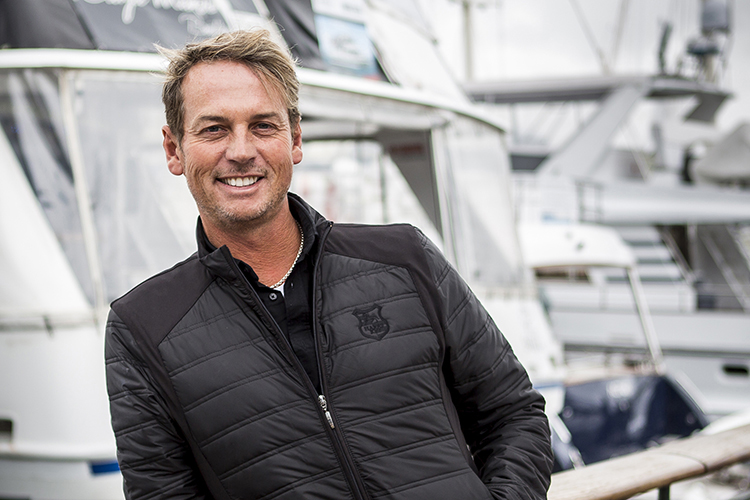
It never gets boring chatting with British dressage superstar Carl Hester. Always fresh and with new irons in the fire. Rebecca Ashton caught up with Carl at Aachen this year to talk about new horses, and the lead up to Paris.
 You keep giving your hopes away to Charlotte. (I’m talking about Charlotte’s latest star Imhotep who is owned by Carl)
You keep giving your hopes away to Charlotte. (I’m talking about Charlotte’s latest star Imhotep who is owned by Carl)
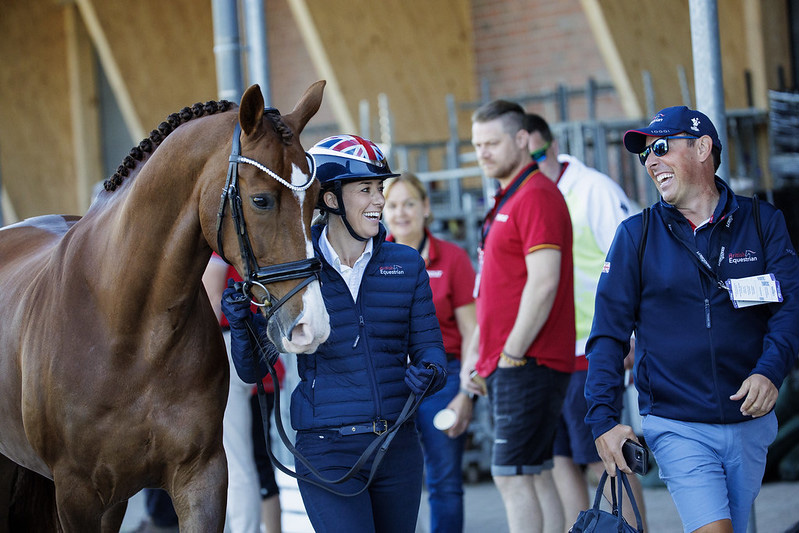
(Photo FEI/Leanjo de Koster)
Do you know what, I’ve had him since he was two. He’s another one, a powerful, impressive horse. He was difficult when he was five, six, seven. He’s a very hot headed character and one of the typical sort of horses we like to have. He had a couple of people in hospital when he was young. He has an amazing back movement, a huge swing and is incredibly supple, and when he decided to flick people off, he could do it pretty easily. You can see the work ethic now though, when you get a horse like that on-side, it ends up being 100% amazing.
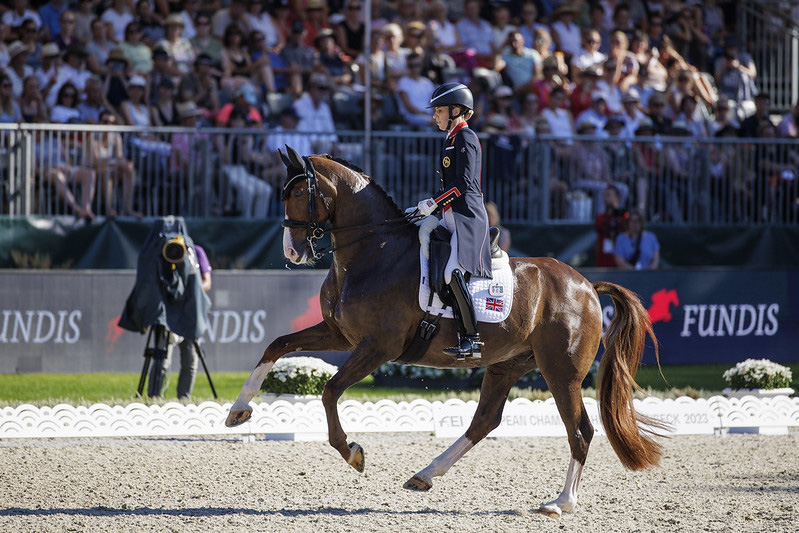
(Photo FEI/Leanjo de Koster)
He needed time and compromise. Like the other horses, he lives in a field, especially with his hot temperament. I rode him a bit when he was seven, and then Charlotte took him on when he was mentally ready for that. Everybody who knows me knows that competing isn’t my big love, but it’s Charlotte’s big love, so it made sense for her to take him out and compete him. As usual, I end up sitting back enjoying watching their journey. Obviously I feel part of it, I own him and have brought him up.
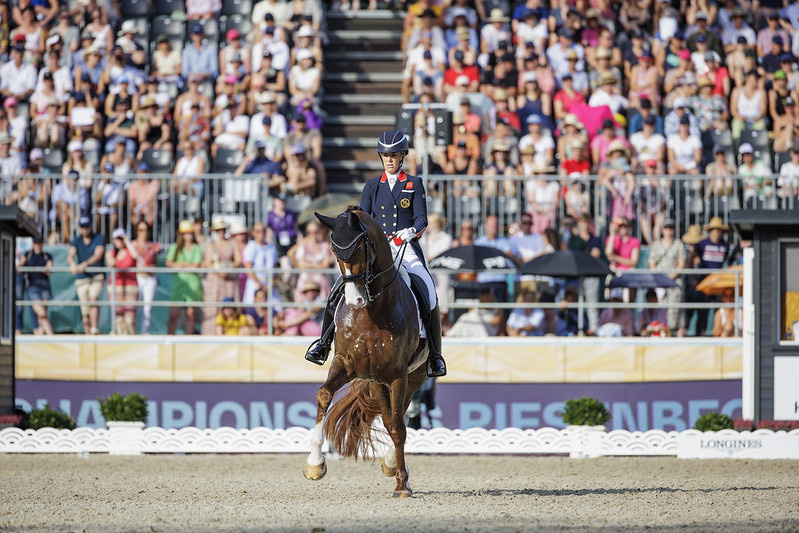
The World Championships was a huge ask for him last year when he was nine. That says a lot about his character. He takes everything by the horns.
That also says a lot about the training as well, wouldn’t you say?
Well, he’s always been brave. He’s like a lion. When you go hacking, he leaves the others behind, he walks so fast. He likes to get the job done.
And Kismet?
Kismet is a beautiful prospect for Charlotte. She was bred and is owned by Peter Balshaw, so she’s British bred. Peter’s wife still rides Kismet’s mum. Peter mainly breeds race horses and ‘Times’ is the prefix he uses for them. With his wife’s passion for dressage, he decided to breed some dressage horses for fun, and of course what do you get? Kismet! She’s a superstar. She’s an elegant, beautiful, stunning horse, and very much Charlotte’s type of ride; very sensitive. When you have something as lovely as that, everybody wants it. I don’t think we’ve ever had so many enquiries as to whether she’s for sale. No she’s not! This is a dream for her owner. She’s only eight. She might possibly be ready for Paris next year, but we’re not going to hurry her.
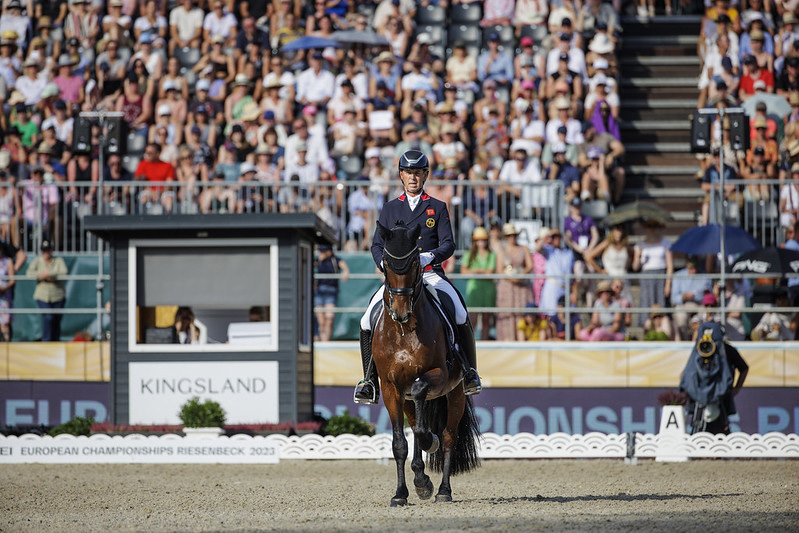
Another Grand Prix horse for Carl – Fame (Photo FEI/Leanjo de Koster)
How do you get them to Grand Prix so young?
The talented horses can get there easily by nine. It’s not about drilling the movements, it’s about their fitness, about having good characters. What people forget when they say, ‘oh that’s too young,’ when you have someone like Charlotte on a horse like that, they balance them. They’re not running around with it on the forehand for hours. It’s fairly common knowledge for anyone who comes to our yard, we only work the horses four times a week. The rest of the time is hacking and fitness and other things. It’s not drilling. They get there because they’re balanced and because they’re talented. We’re also open to using in hand work, treadmills and water treadmills for fitness.
There’s more science in the sport now…
It’s been revolutionary. I find it fascinating because I’ve been doing the sport for 35 years at an international level. When I first came into the sport, it was just about schooling really. Welfare has become more important, the way of keeping horses has become more important, things you can do to help them with fitness, soundness, saddle fitting and tack. Rider fitness and suppleness for riders has become big as well. The really good riders now should be called athletes because they also have to focus on themselves. We’ve embraced it. Sport in the UK is funded and they give you the science. Embracing all these other things comes with being part of a programme. Anybody who wants to win knows that margins are important. You need them and they’re tiny.
You’ve got Fame and En Vogue
Fame belongs to Fiona Bigwood. Fiona is a busy mum with three kids who are all riding and showjumping and Fame is a full time job. Fiona knows my passion for those full time job horses. You do have to dedicate yourself to Fame. He is just the coolest. I absolutely worship him. He’s wonderfully talented and desperately keen. To think that, coming towards the end of my career I have a horse like him and Vogue is just so fortunate because I can’t wait to get up everyday.
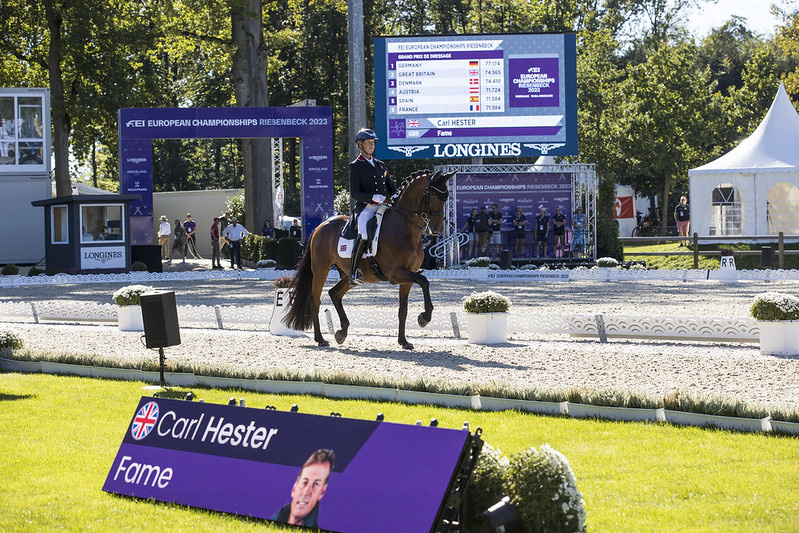
(Photo FEI/Leanjo de Koster)
Fame’s a 13-year-old stallion. He’s done about seven Grand Prix this year, and never got under 75%. He was quite well known for his hotness. Fiona said you’ll get a shock when you go to a show. He can rise out of the ashes and turn into fire. It’s in a genuine way, and I love that. Despite how tense he can sometimes be, he hardly ever makes a mistake. (Carl has a massive grin on his face). He’s exciting. I spend my life chattering to him. He’s just a mate.
Vogue has come back even better this year. He’s 14 and more mature now. He’s been a labour of love as well with his nerves. I was always thinking, ‘I wonder if he will, I wonder if he won’t?’. Tokyo was made for him because it was about the Grand Prix Special and he’s always better in his second test. Also the weather, and the lack of atmosphere, but I have to say, when you get down to the nitty gritty of three on a team and every score counts, going down the centreline on Vogue knowing you are one of the three is quite daunting. because I was never quite sure if he would do it. Then he did the best Special he’s ever done with over 78% and a team medal.
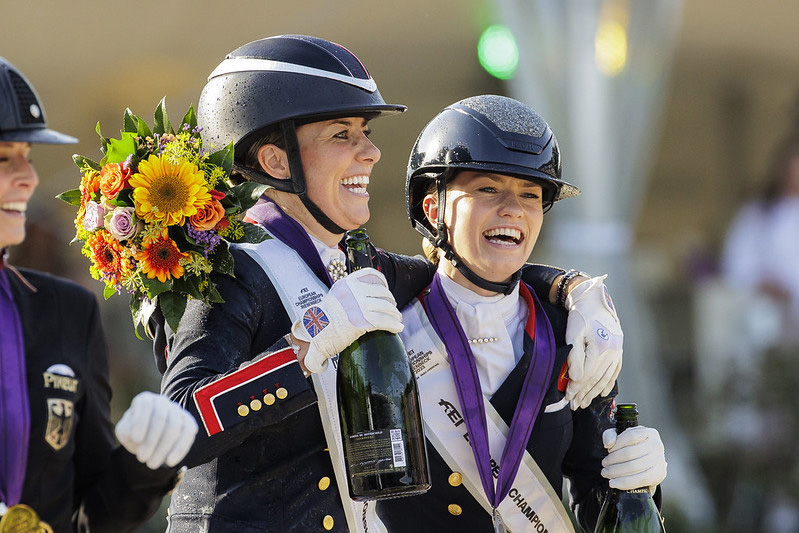
Charlotte and Lottie, hard to get past! (Photo FEI/Leanjo de Koster)
So the two of them are great talents. For Paris, I’ll try both of them and see. Obviously my Charlotte and Lottie are fairly difficult to get past. They‘re superwomen those two. They’ve actually done great things for each other. They spar off each other now, they want to beat each other and that’s bringing a really high standard at that level. If you want to win a team medal next year, you’ve got to be over that 75%. You’ve got to be between 75-80% to join the team. So, I would love to be able to do it, but I don’t take anything for granted because I had two horses for Beijing and both of them had injuries between May and selection in June that year and I missed out. That was with two horses going, so you have to be realistic. Quietly inside I know they’re good enough, but we’ll wait and see what happens.
Your Worlds commentary was great. It was really informative
I enjoyed it. A commentator will look at it from their knowledge, probably normally as a judge or a trainer. I’m a rider and a trainer, so I can talk about what I would be doing at that moment or why that moment went wrong or right. It gave me something to do because I didn’t ride. I was coaching, but the stress of competing, it was so lovely not to have it. The only time I slipped up was when we arrived and did the trot up and afterwards they wanted a team photo. I was right in the middle of it waiting for the photo and it was like, urrr, not you. Yes, remember your place Carl Hester! Apart from that, we had an absolute ball. I loved the team. Winning a medal, Lottie being World Champion. Incredible story there as well.
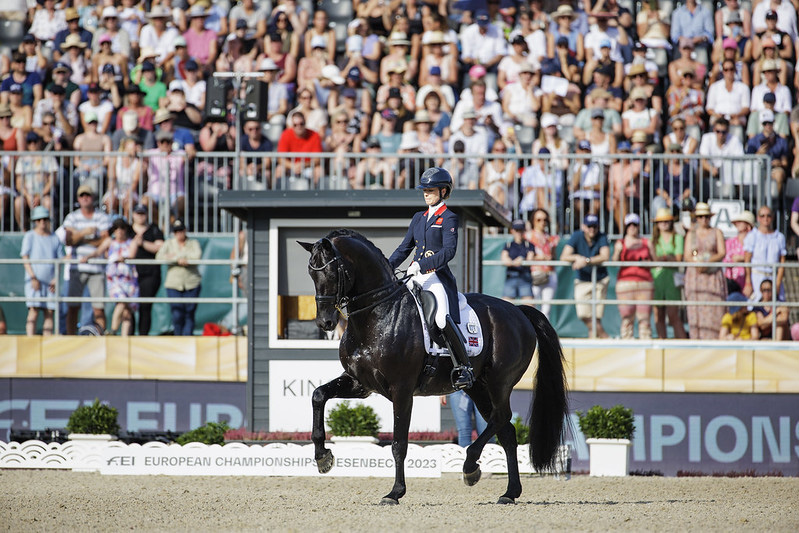
Lottie and Glamourdale, champions (Photo FEI/Leanjo de Koster)
You’ve been part of that. Tell us about Lottie, your perspective.
Lottie’s mother Laura and I were good friends. I taught her mum and Lottie would come and watch when she was 13, 14 years old. I mostly teach adults so Laura always said to me, when Lottie’s old enough will you teach her? I said yes. The tragedy was that Laura died of cancer very young. Lottie was a very dedicated rider, but very weak. Now it’s incredible what her body has turned into, so strong. The stallions she rides, she’s little and she’s riding 17-18 horses a day. It’s incredible to see that.
She dedicated herself to being better, but by the time Lottie was old enough, I had Charlotte. I said there’s not room for two riders here, but I wanted to help her, so I suggested a job in Holland. Anne Van Olst is a good friend, I told her how hard Lottie works and how talented she was and now Anne can’t believe how it’s worked out. Anne’s competed at Olympics, she’s been there, done that, and she’s retired from the sport now. When you do that, it’s really exciting when there’s someone else, especially someone you’ve trained up and brought up with your own horses, your own breeding. That’s how I feel with Charlotte riding my horses.
When people ask if it’s a rivalry, it’s nothing to do with that. I mean, I expect her to beat me so there’s definitely no rivalry! We all help each other. That’s what being on the team is about.
You’ve got a lot of people on your team. When someone competes, there are a lot of blue shirts standing by.
People laugh. We went from nothing to having an army. We started winning medals, we got funding. It just takes the stress out of competing. If someone can just focus on a performance and not how you get there, what you do when you get there, who’s looking after your horse, when do you have to do that, who’s going to shoe it. We all know how stressful that is. I’m pretty sure that’s where the extra marks come from, having a good team.
Do you ever wake up in the morning and think with the stress of it all, why am I still doing it?
Of course I do. I’ll never not love riding, that’s not an issue. It’s just the competing, but I do it because at the moment hopefully I’m one of the best in the UK, I’m competitive and I can be on the team and add to it. My whole thing is not about what I can win, but what the team can win. If the team is in a winning position, it’s inspiring to other riders. Individuals, yes they can be inspiring, but people look at that and think that could never be me; they come from a wealthy background, they have an amazing horse or whatever. I think when you see a team with diverse people on it, different characters with different ways of getting there, that’s inspirational. A quick rundown of the backstories of the current team members is hilarious; I come from an island of 500 people with no cars, Charlotte came to work for me as a groom, Lottie’s mother died and she was sent to work in Holland and Gareth started off as a cowboy in Oz. I mean, isn’t it brilliant? How could anyone say that couldn’t be me? There you have four riders winning medals from four very different backgrounds.
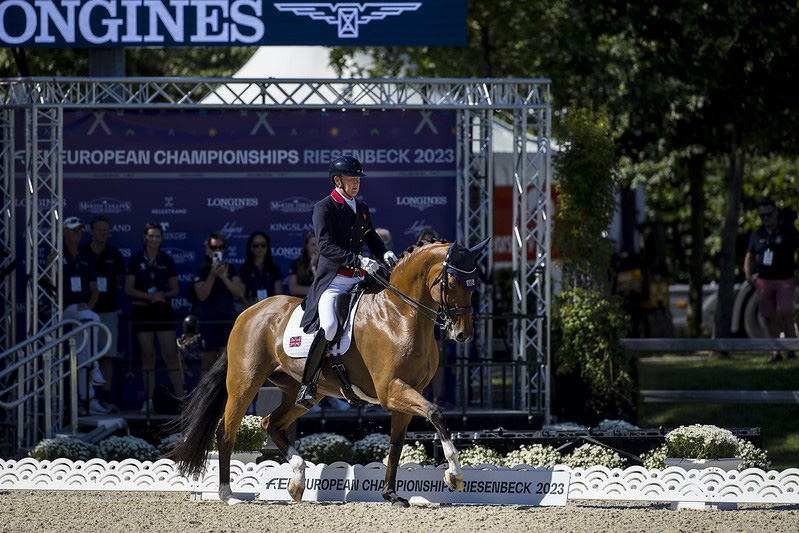
Gareth Hughes and Classic Briolinca – Aussie cowboy! (Photo FEI/Leanjo de Koster)
What’s your plan towards Paris?
We’ll keep the horses fit and sound during winter, hacking, no competing then we’ll make a plan for next year. It’s difficult to plan that far ahead, but we’ll see.
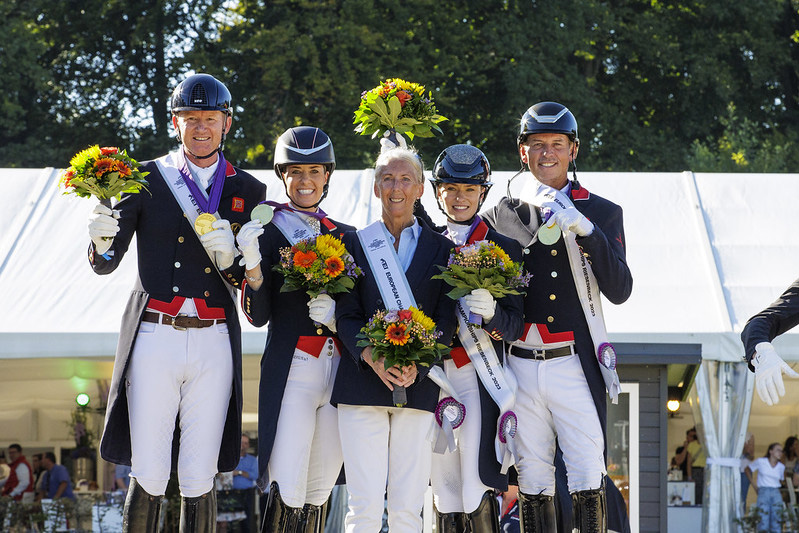
Four riders from four very different backgrounds: Gareth Hughes, Charlotte Dujardin, Charlotte Fry, and Carl…
(Photo FEI/Leanjo de Koster)
Breeding a dressage star in Australia this season? See the amazing range of top European bloodlines available from International Horse Breeders:
www.ihb.com.au
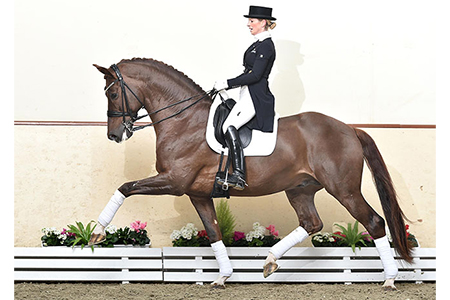
Vitalis
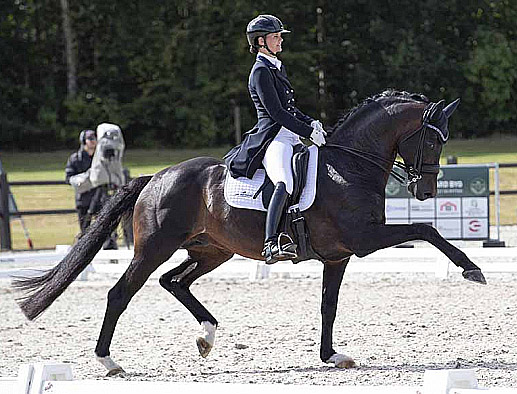
Franklin

Love the Carl Hester interview – great read.
Carl has to be one of the best things that ever happened to Dressage! Thank you so much Rebecca Ashton for asking so many great questions and including wonderful pictures. Carl and his horses are a Joy to watch, and he so generously shares his knowledge! Kudos all round 🙂